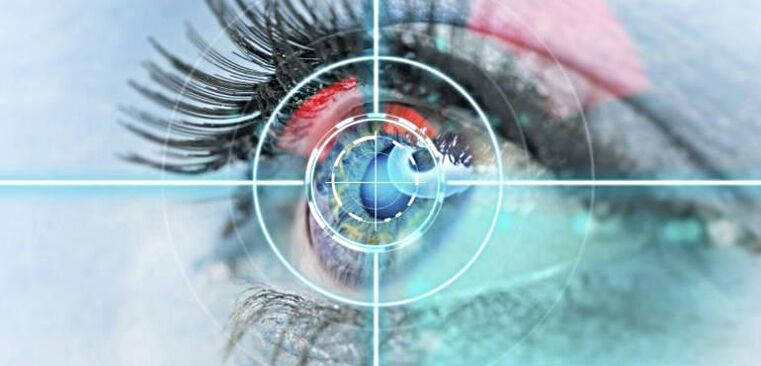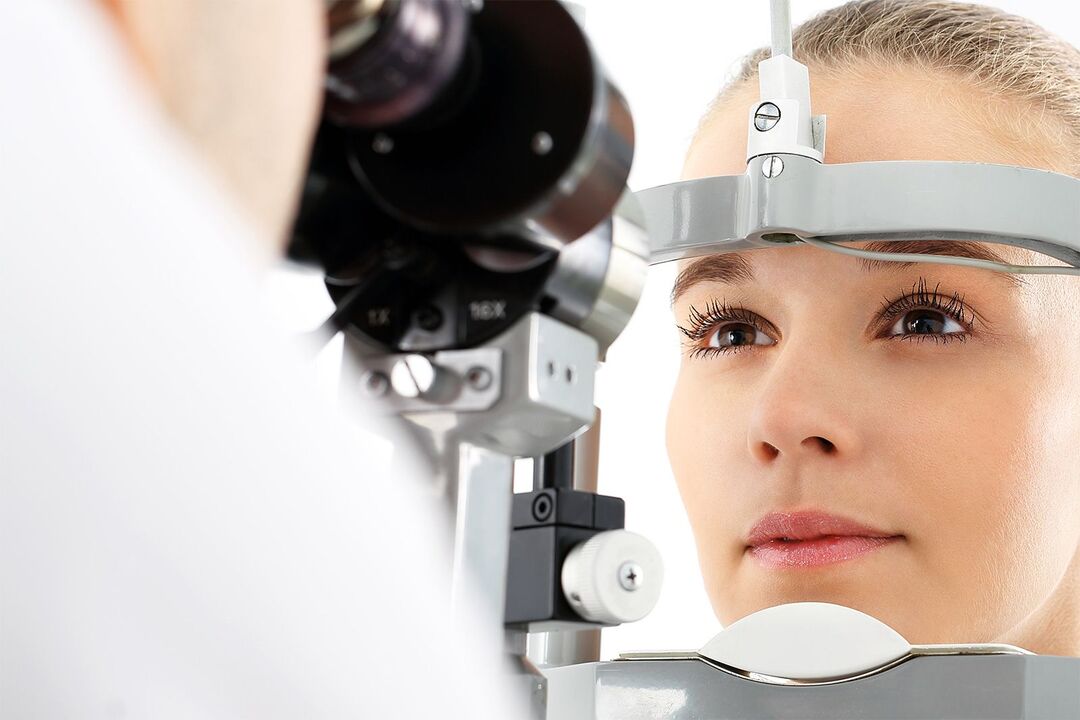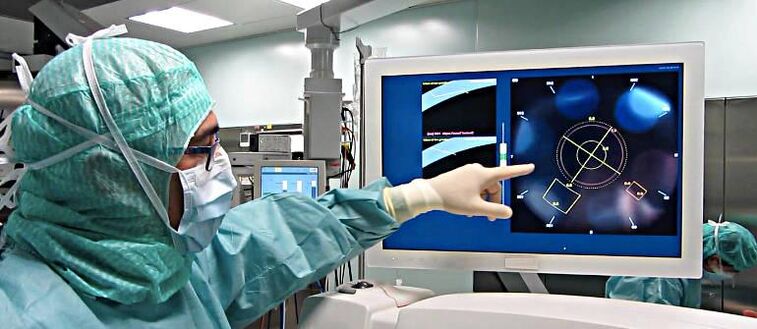Excimer laser surgery changes the shape of the cornea. As a result of such operations, the human optical system becomes more perfect and the patient no longer needs to use optical correction products (glasses or contact lenses).
It is important to note that during the surgical treatment of astigmatism, the refraction of the retina changes, so that the rays from the image focus clearly on the macular area. At the same time, vision becomes significantly better.

Why does vision decrease?
Refraction refers to the optical power of the entire eye. Refraction is usually expressed in diopters. When this function is impaired, vision declines, leading to a decrease in quality of life.
Astigmatism, nearsightedness and farsightedness are in all cases accompanied by a decrease in visual acuity. Any refractive error leads to the fact that the focus of light rays is not in the plane of the retina, but in front or behind it. Therefore, such patients need correction of visual function using external optical devices (glasses or contact lenses). This need can cause some inconvenience and is sometimes unsafe.
Among the diseases associated with refractive error, myopia is the most common disease. According to statistics, 1/3 of Earth's inhabitants suffer from nearsightedness. This disease can be diagnosed at any age, but most myopia patients are usually diagnosed between the ages of 8-16 years old. In the future, the disease may stabilize or continue to progress. In all cases, myopia affects the quality of life, causes discomfort for the patient and therefore requires close attention from a specialist.
It should be noted that any visual impairment requires mandatory correction. Many people think that when using glasses to correct vision, vision will decrease, but this is not true. On the contrary, if you do not use any correction methods, your eyes may stop working, which will certainly lead to amblyopia over time. In this case, even perfect vision correction cannot reach 100%.
Why do you need laser vision correction?
Because many people suffer from refractive errors (farsightedness, astigmatism, myopia), experts are constantly developing new effective treatment methods. One of the new highly effective methods for ametropia is laser visual rehabilitation.
Despite the fact that both eyeglasses and contact lenses are popular, easy to use and affordable, every day thousands of people turn to specialists with a request to have laser vision correction performed.
It's quite simple to explain why this happens. Firstly, even the most modern glasses bring a certain feeling of discomfort to their owner. When worn for a long time, there will be pressure on the bridge of the nose and ears, sometimes accompanied by pain. Wearing glasses in winter is also very inconvenient, because when the temperature changes sharply in a warm room, the glasses will immediately fog up. In addition, when participating in active sports, glasses are not only uncomfortable but can also be dangerous.
Glasses, like contact lenses, can be forgotten or lost, so prudent people always have an extra pair as replacements.
If you choose the right contact lenses, they will definitely cause less discomfort. For example, the lenses do not fog up, do not put pressure on the bridge of the nose, and are comfortable for active activities. However, when using any type of contact lens, including the most modern lenses, the oxygen concentration in corneal cells decreases. As a result, blood vessels from the underlying layers begin to grow into the cornea and dry eye syndrome may also develop over time. Most of the time, irreversible eye changes occur 5-10 years after starting to use contact lenses. After that, patients often have to switch to glasses or find another alternative.
Laser treatment of refractive errors helps patients permanently give up contact lenses and eyeglasses, so this treatment method brings a high standard of living.
It is important to know that not all patients are suitable for laser vision loss treatment. For example, children under 18 cannot have laser correction because their eyeballs are not fully developed. For this type of patient, eyeglasses and contact lenses are the only possible way to improve vision. In this case, it is important to wear glasses correctly so as not to cause irreversible changes to the cornea. An ophthalmologist will help you with this if you visit regularly and monitor the progress of vision changes.

Preoperative preparation for laser vision correction
To have laser vision correction surgery, you must first have a comprehensive ophthalmological exam. During diagnosis, the doctor evaluates the condition of the eyeball as a whole and all its structures separately. Many important parameters are also measured.
The main diagnostic methods include:
- Optometry, that is, measuring visual acuity;
- Blood gas measurement, necessary to determine the value of intraocular pressure;
- Pachymetry, which measures the thickness of the cornea;
- Automated refraction, in which the refraction of the eye is determined automatically;
- Ultrasound measurements are needed to measure the length of the eye;
- Perimetry, that is, determining the boundaries of the field of view;
- The Schrimer test is needed to evaluate tear production;
- Corneal topography analysis by computer, this is a modern method to clarify the structure of the cornea;
- Examine fundus structures after preliminary maximal dilation of the pupil using drops.
After careful preoperative preparation and diagnosis, the doctor can speak with certainty about the results the patient can expect after laser correction. This also allows you to avoid the most common complications in the postoperative period.
How is laser vision correction performed?
During surgery, minimally invasive effects are made on the substance of the cornea, which leads to a change in the curvature of its surface.
After the doctor adjusts the shape of the cornea with laser stimulation, the rays from the image will focus at a point exactly in the plane of the retina. All methods used in modern medicine are very safe, accurate and provide high vision.
The process of laser vision correction lasts on average about 10-15 minutes. During surgery, local anesthesia is used, which is administered using special eye drops. This allows you to minimize pain, both during and after the procedure. After surgery is completed, the patient is monitored in the clinic for about an hour and a half. Then the patient is sent home, having previously given all the recommendations. It is important to note that laser vision correction surgery has virtually no impact on the patient's lifestyle, meaning that limitations in the postoperative period are minimal.
At the stage of a full medical examination, the doctor will give all explanations regarding the features of the preoperative and recovery period. To systematize this information, there are very convenient reminders in which the patient will find answers to all his questions.
Benefits of restoring vision with Excimer laser
Excimer laser vision correction is a very popular procedure requested in all countries.
Advantages of the method include:
- Reliability of results;
- No pain;
- Speed of execution (no more than a quarter of an hour);
- Safety;
- Perform outpatient operations;
- Many possibilities;
- Short recovery time;
- Results are predictable and predictable with high accuracy;
- No cuts or seams;
- Simplicity and accessibility;
- No additional testing is required;
- High efficiency lasts a lifetime.
It should be noted that, although the possibilities for laser vision correction are very wide, this operation does not guarantee the absence of various eye pathologies in the future.

Contraindications for laser vision restoration
Unfortunately, it is not always possible to perform laser visual function correction. All contraindications to this operation can be divided into two large groups: temporary and permanent. Among temporary contraindications, the most common are reversible eye (or whole body) diseases. After these diseases are cured, it is possible to perform laser correction. Temporary contraindications include:
- Myopia progresses due to refractive instability;
- Acute inflammatory changes, both in the eyes and in other body systems;
- Pregnant;
- Breastfeeding period;
- Changes in the fundus, including rupture and dystrophic changes;
- Degenerative process in corneal cells.
If there are constant contraindications, laser vision correction will become impossible. These include:
- thin cornea;
- glaucoma;
- Lens radius;
- retinal detachment;
- Cataracts;
- Decompensated diabetes;
- Previous surgical treatment for retinal detachment.
Interestingly, even if there are absolute contraindications to laser vision correction, you can still choose an effective alternative treatment that helps restore vision.
The main difference between laser surgery and other techniques
Laser correction of refractive errors includes several types. After reading the name, most patients do not understand the essence of the operation, because abbreviations or established terminology are mainly used. A distinctive feature of REIC and LASIK operations from SuperLASIK is the second stage of the operation, when a femtosecond laser participates in the process.
The term SuperLASIK, as used in practice, is not entirely accurate, since patients may think that the conventional LASIK technique is somehow inferior to it and inferior. In foreign literature, a more precise term is used (custom LASIK). In translation, this operation should be called personalized LASIK. This is not to say that traditional LASIK surgery has disadvantages. It's just that in some special cases you should get SuperLASIK done, while in other cases you can limit yourself to a simple LASIK operation. That is why, when choosing a laser vision correction method, it is recommended to use an individual method, taking into account preoperative examination data.
An important difference between FemtoLASIK and traditional laser correction is that the operation is completely non-contact. The first stage, in which the surface flap of the cornea is cut with a microkeratome blade, in FemtoLASIK is performed using a femtosecond laser. This technique is still quite new, so not enough experience has accumulated to clearly determine its effectiveness and safety.
Some doctors believe that femtosecond lasers are much safer than microkeratomes, but other experts disagree with this statement and prefer mechanical flap formation.
Another new laser vision correction method is the Smail maneuver. In this procedure, only a femtosecond laser is used and there is no stage of surface valve formation from corneal tissue. In this case, the refractive portion is immediately formed in the deep layers of the cornea. The second part is removed through a minimal incision (2-4 mm) in the surface layers of the cornea using a special instrument. This incision is also made with a femtosecond laser.
It is very important to understand that vision and eyes are one of the most important tools for humans to interact with the outside world. Few people can disagree that a person needs eyes constantly, that is, 365 days a year. That's why it's so important to take care of them from an early age.

























